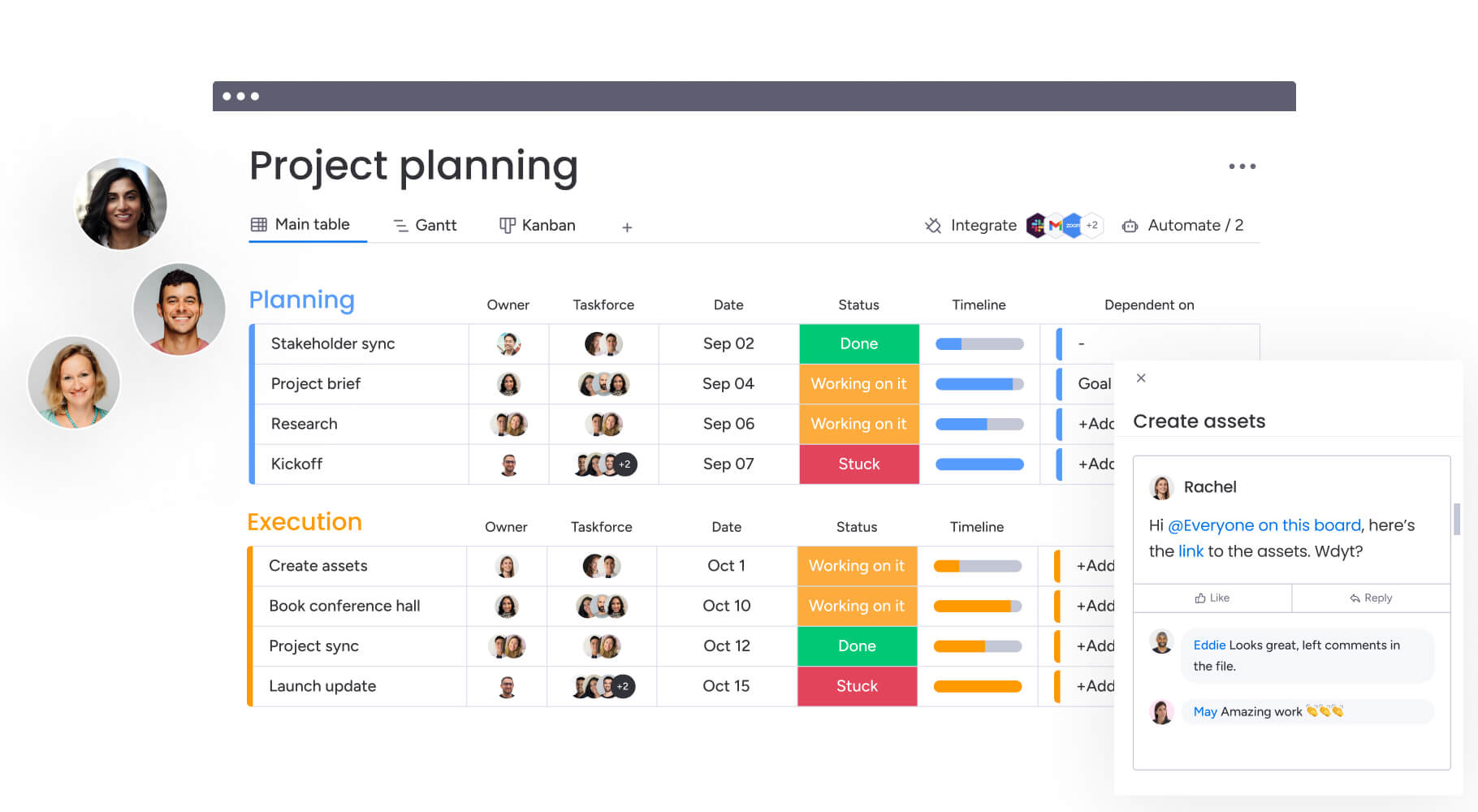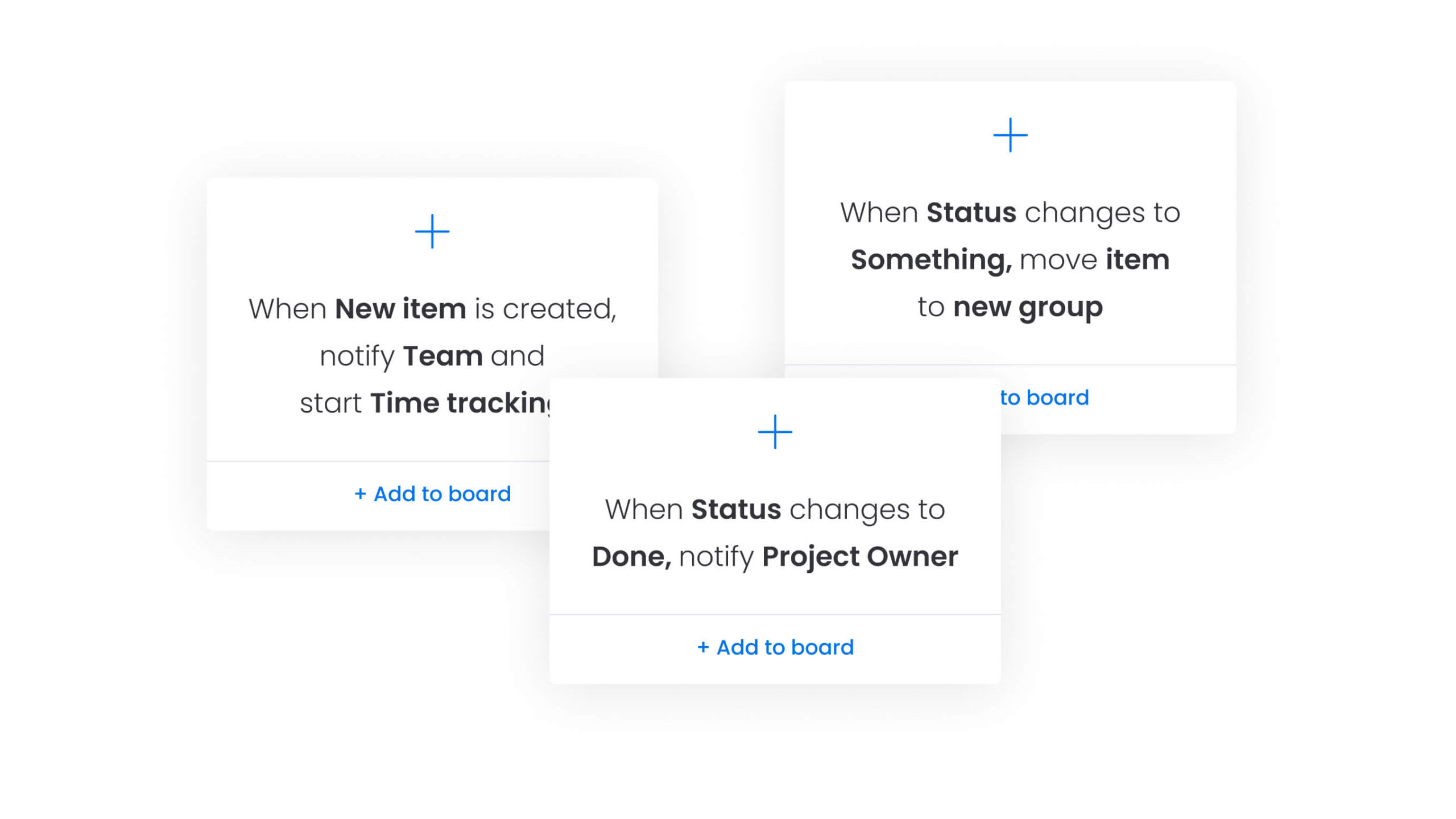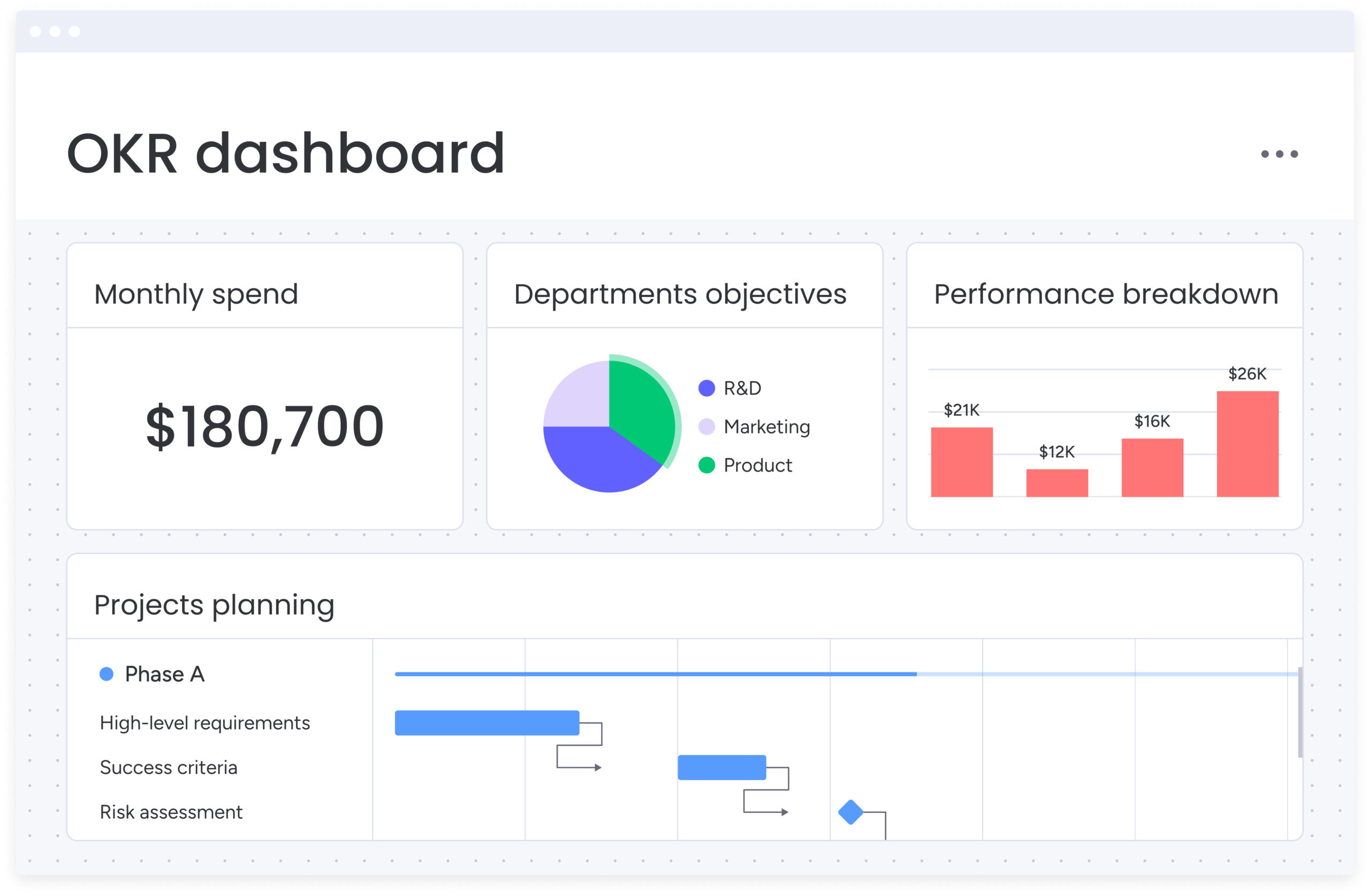Successful IT projects require both strategic vision and tactical precision. Every technological initiative represents a potential turning point for your organization, and is capable of transforming operations, enhancing customer experiences, or creating entirely new business capabilities.
This guide explores 10 types of IT projects that deliver measurable business value, along with proven strategies for successful implementation. With monday work management’s customizable workflows and real-time collaboration features, teams can visualize progress, identify bottlenecks, and adapt quickly to changing requirements.
Try monday work managementWhy IT projects are important for organizational growth
An IT project is a structured initiative that leverages technology to solve business problems, improve operations, or create new opportunities. These range from simple software upgrades to complex digital transformations that reshape entire business models.
Organizations invest in information technology projects to maintain competitive advantage in increasingly digital markets. Most business leaders recognize they ” don’t need to learn to code ” but instead need to develop digital collaboration skills to work effectively with technical teams.
IT projects create value through several key mechanisms:
- Strategic alignment: Connects technology directly to business goals
- Competitive advantage: Helps organizations differentiate through enhanced capabilities
- Operational efficiency: Streamlines workflows and optimizes resources
- Innovation enablement: Creates foundations that support experimentation
The most successful IT projects share three characteristics: clear business objectives, strong executive sponsorship, and active stakeholder engagement throughout implementation.
How IT teams overcome key challenges
Understanding common challenges helps organizations develop mitigation strategies and increase their chances of success. monday work management provides a vizualization platform that highlights potential risks before they derail projects.
Scope creep occurs when requirements continuously expand beyond initial agreements. This leads to budget overruns and missed deadlines. Establishing rigorous change management processes helps contain scope while allowing necessary adjustments.
Resource constraints emerge when IT teams juggle multiple priorities with limited personnel or expertise. Effective capacity planning becomes critical for maintaining momentum across competing initiatives.
Stakeholder alignment issues arise when departments have conflicting priorities. Without consensus on objectives, projects can deliver results that satisfy no one. Regular communication helps maintain alignment throughout the project lifecycle.
Technical complexity often exceeds initial estimates, particularly when integrating with legacy systems. Breaking complex projects into manageable phases allows teams to address challenges incrementally.
10 types of IT projects that accelerate value
Understanding different categories of IT projects helps organizations prioritize initiatives based on their specific business needs. Each project type addresses distinct challenges while delivering unique benefits.
1. Software upgrades and custom development
Software development encompasses implementing commercial solutions or building custom applications that address specific business needs. These example IT projects deliver value by enhancing functionality, improving user experiences, or creating entirely new capabilities.
Organizations pursue software upgrades when existing applications no longer meet requirements. Custom development becomes necessary when commercial solutions don’t address unique business processes or when organizations seek competitive differentiation.
Successful software projects require:
- Clear requirements documentation
- Iterative development approaches
- Comprehensive testing strategies
- Thoughtful user adoption planning
2. Cloud migration and optimization
Cloud migration involves moving applications, data, and infrastructure from on-premises environments to cloud platforms. These initiatives help organizations reduce capital expenditures, improve scalability, and enhance business continuity.
Different cloud models serve distinct business needs:
- Public cloud: Provides maximum scalability with minimal management
- Private cloud: Offers greater control for sensitive workloads
- Hybrid cloud: Balances flexibility and control for diverse applications
Cloud optimization extends beyond initial migration to ensure organizations maximize their investments through right-sizing resources and implementing automation.
3. Data analytics and business intelligence
Data projects transform raw information into actionable insights that drive more informed decision-making. Organizations implement data analytics to gain competitive advantage through deeper customer understanding and more efficient operations.
The analytics journey typically progresses through increasingly sophisticated approaches:
- Descriptive analytics: Explains what happened through historical reporting
- Diagnostic analytics: Explores why it happened through root cause analysis
- Predictive analytics: Forecasts what might happen using statistical models
- Prescriptive analytics: Recommends actions based on expected outcomes
monday work management’s visualization capabilities help teams translate complex data into intuitive dashboards that drive action rather than just presenting information.
4. Cybersecurity and risk management
Security projects protect critical business assets, maintain customer trust, and ensure regulatory compliance. These initiatives have become increasingly important as cyber threats grow more sophisticated.
Comprehensive security programs address multiple protection layers:
- Network security: Defends the organizational perimeter
- Endpoint security: Protects individual devices
- Application security: Ensures software is developed securely
- Data security: Safeguards sensitive information regardless of location
- Identity management: Controls access to systems and information
Beyond technical controls, effective security projects also address human factors through awareness training and process improvements.
5. AI integration for smarter workflows
AI implementation projects leverage machine learning and other advanced technologies to automate complex tasks and enhance decision-making. These initiatives help organizations process larger volumes of information and identify patterns humans might miss.
Practical AI applications deliver immediate business value through:
- Process automation that handles routine tasks
- Decision support that augments human judgment
- Customer experience enhancements that create personalized interactions
- Predictive maintenance that identifies potential failures before they occur
6. Infrastructure and network modernization
Infrastructure projects build the foundation that supports all other IT initiatives. These IT support projects ensure systems remain reliable, scalable, and secure as business needs evolve.
Modern infrastructure provides the agility organizations need to respond quickly to changing market conditions. It encompasses several key components:
- Computing resources that scale with demand
- Storage solutions that balance performance and cost
- Network infrastructure that connects users, applications, and data
- Physical facilities that house technology components
Successful infrastructure modernization aligns technical architecture with business requirements while balancing immediate needs with long-term flexibility.
7. Legacy system overhaul
Legacy modernization addresses the challenges of maintaining outdated systems that have become expensive to operate and incompatible with modern security requirements. These initiatives help organizations reduce technical debt while creating platforms for future innovation.
Organizations approach legacy modernization through several strategies:
- Rehosting: Moves existing applications to modern infrastructure
- Refactoring: Improves internal code structure without changing behavior
- Rearchitecting: Redesigns applications to leverage modern technologies
- Rebuilding: Recreates functionality from scratch using current approaches
- Replacing: Substitutes legacy applications with commercial alternatives
Phased approaches often prove more successful than “big bang” replacements that introduce significant operational risk.
8. Advanced automation and IT implementations
Automation projects streamline repetitive tasks, improve consistency, and free human resources for higher-value activities. These it implementations help organizations accomplish more with existing resources while improving quality.
Effective automation targets processes with specific characteristics:
- High volume of repetitive activities
- Rule-based decision making
- Stable, well-documented procedures
- Significant manual effort
- Error-prone human execution
monday work management’s automation capabilities allow teams to create custom workflows that eliminate manual handoffs, trigger notifications, and update related items automatically as projects progress.
9. Custom enterprise resource planning
ERP projects integrate core business processes into unified systems that provide consistent data and standardized workflows. These initiatives help eliminate silos, improve data quality, and enhance operational efficiency.
Modern ERP implementations differ significantly from traditional approaches:
- Cloud-based deployment: Accelerates implementation and reduces costs
- Modular architecture: Allows phased implementation of specific capabilities
- Configuration over customization: Reduces complexity and maintenance
- User-centric design: Improves adoption and productivity
Successful ERP projects require executive sponsorship, cross-functional involvement, and careful change management focused on business outcomes rather than technical features.
10. Digital transformation initiatives
Digital transformation encompasses comprehensive changes to business models, customer experiences, and operational processes enabled by technology. These information technology projects examples help organizations remain competitive by fundamentally rethinking how they create value.
Effective digital transformation extends beyond technology to address:
- Business strategy and operating models
- Organizational structure and culture
- Talent acquisition and development
- Process redesign and optimization
- Customer engagement and experience
What digital transformation initiatives would create the most value for your organization?
Try monday work managementSteps to plan and implement projects successfully
Successful IT project management follows a structured approach that maximizes value while minimizing risks. These steps create a framework adaptable to any project in IT , from simple implementations to complex transformations.
1. Define clear objectives and scope
Effective IT projects begin with well-defined business objectives that connect technology investments to organizational goals. These objectives should be specific, measurable, achievable, relevant, and time-bound (SMART) to provide clear direction.
Scope definition establishes boundaries around what the project will and won’t deliver. This includes functional requirements, technical parameters, and implementation constraints. Documenting scope helps prevent misunderstandings and provides a baseline for evaluating change requests.
Successful scope management requires stakeholder involvement in requirement definition and formal change control processes throughout the project lifecycle.
2. Establish budgets and timelines
Financial planning encompasses both initial implementation costs and ongoing operational expenses. Comprehensive budgets include hardware, software, services, internal labor, training, and contingency reserves.
Timeline development requires understanding dependencies, resource availability, and realistic work estimates. Effective schedules include key milestones that provide visibility into progress and create natural checkpoints for assessing project health.
The approach you choose depends on project complexity, requirements stability, and organizational culture:
- Agile methods: Break work into smaller increments with frequent reassessment
- Waterfall methods: Map out the entire project timeline in advance
- Hybrid approaches: Combine elements of both methodologies
3. Build a skilled project team
Team composition directly impacts project success. Effective teams combine technical expertise with business knowledge, communication skills, and problem-solving abilities. Key roles typically include:
- Project sponsors who provide executive support
- Project managers who coordinate activities
- Business analysts who translate business needs into requirements
- Technical specialists who implement solutions
- Change management resources who facilitate adoption
monday work management enables effective team collaboration through centralized communication, clear task assignments, and transparent progress tracking.

4. Leverage collaboration tools and automations
Modern project management platforms streamline communication, automate routine tasks, and provide real-time visibility. These tools help teams work more efficiently while reducing administrative overhead.
Effective collaboration solutions provide these essential capabilities:
- Centralized documentation: Ensures everyone works from current information
- Task tracking: Establishes clear ownership and deadlines
- Automated notifications: Alerts when items require attention
- Status visualization: Makes progress visible to all stakeholders
- Integrated communication: Maintains context around discussions
monday work management’s automation capabilities eliminate manual work by automatically updating statuses, sending notifications, and triggering dependent tasks when conditions are met.

5. Monitor progress and adjust quickly
Regular monitoring helps teams identify issues early when they’re easier to address. Effective project controls include:
- Status meetings focused on accomplishments and obstacles
- Dashboards that visualize key performance indicators
- Risk registers that track potential issues
- Change logs that document scope modifications
Agile adaptation allows teams to respond to changing requirements or unexpected challenges. This requires establishing feedback loops and empowering team members to raise concerns quickly.
How AI shapes modern IT initiatives
Artificial intelligence is transforming how organizations plan and execute IT projects. These technologies help teams work smarter by automating routine tasks and providing data-driven insights.
AI capabilities enhance multiple aspects of project management:
- Predictive analytics: Identifies potential risks before they impact schedules
- Automated resource allocation: Optimizes team assignments based on skills
- Natural language processing: Extracts key information from requirements documents
- Machine learning: Improves estimation accuracy by analyzing historical performance
monday work management integrates AI throughout its platform to help teams identify bottlenecks, suggest process improvements, and automate routine tasks that would otherwise consume valuable time.

Measuring outcomes and return on investment
Effective measurement frameworks help organizations assess whether projects deliver expected benefits. These frameworks should balance quantitative metrics with qualitative assessments to provide a complete picture of success.
When evaluating examples of it projects for project management, consider these key metric categories:
- Financial metrics: ROI, payback period, cost savings
- Operational metrics: Efficiency gains, error reduction, time savings
- Strategic metrics: Market position improvement, innovation capacity
- User metrics: Adoption rates, satisfaction scores, productivity impact
monday work management’s dashboards enable teams to visualize these metrics in real-time, helping stakeholders understand project performance and make data-driven decisions.

Empower your organization with future-ready projects
Strategic IT projects transform how organizations operate, engage customers, and compete in digital markets. By understanding different types of initiatives and following structured implementation approaches, teams can maximize technology investments while minimizing risks.
Successful projects require more than technical expertise — they demand clear business alignment, effective collaboration, and continuous adaptation. Organizations that master these disciplines create sustainable competitive advantage through technology.
FAQs
What are examples of IT projects?
Examples of IT projects include developing a custom CRM system, migrating company data to the cloud, implementing an ERP solution, and launching a cybersecurity training program.
How do I measure ROI for technology projects?
To measure ROI for technology projects, subtract the total project costs from the financial benefits gained, then divide by the project costs; key metrics include cost savings, revenue increases, and risk reduction.
Do I need certifications to manage an IT project?
While certifications can be helpful, you do not need them to manage an IT project—practical experience and using the right project management platform are often more important.
Can AI be used to streamline IT project management?
Yes, AI can streamline IT project management by automating routine tasks, identifying risks, and providing actionable insights—monday work management’s AI features make this accessible to any team.
How do I choose the best platform for my organization?
To choose the best platform, consider scalability, integration capabilities with your existing tools, and ease of use for your team.
Are there low-code ways to start an IT implementation?
Yes, low-code and no-code platforms allow non-technical teams to build and launch IT solutions quickly, making technology projects more accessible across the organization.
